

While the global media spotlight fixates on the delivery of missiles and tanks to Ukraine, drones have quietly emerged as the true game-changer in the theater of war, actively deployed by both conflicting parties. In the realm of Putin's military, emphasis is placed on Orlans and Lancets, while on the Ukrainian front, volunteers craft cutting-edge, garage-built FPV drones—remote-controlled marvels whose efficacy surpasses even the pinnacle of contemporary artillery (the triumph of FPV drones has prompted the Kremlin to initiate their large-scale production). Drones have altered the situation to such an extent that both nations find themselves engaged in recalibration of their military strategies, constantly adapting to the ever-evolving realities of the battlefield.
Content
Airdrop evolution: Baba-Yaga and Punisher vs Russian Forces
FPV Revolution
Fixed-wing drones: the downfall of the Bayraktar, the rise of the Orlan and Lancet
Strategic UAVs: Shaheds, Beavers, and Ukroshaheds
Countering drones
Airdrop evolution: Baba-Yaga and Punisher vs Russian Forces
From the outset of the full-scale war, Ukraine embraced a widespread use of drone-delivered munitions, a practice previously confined to a few enthusiasts within the ranks of the Armed Forces of Ukraine (AFU). In the face of frequent shortages of artillery shells and other munitions, these “drops,” as they are dubbed in the Ukrainian military, evolved beyond mere “free hunting” of Russian soldiers. They found a new purpose in providing support to Ukrainian infantry during the assault on Russian positions.
The production and development of munitions for drones have burgeoned into a distinct sector of the military-industrial complex. Notably decentralized, this industry has proven resilient to potential disruption by Russian missile strikes. Munitions of enhanced potency, both fragmentation anti-personnel and high-explosive anti-armor, are being manufactured. Tail stabilizers are 3D-printed to accompany them, ensuring a steady descent without erratic maneuvers and thus facilitating the activation of the frontal fuze. Russian “volunteer” suppliers, initially trailing behind their Ukrainian counterparts, are catching up, establishing their own production capabilities and logistics to compensate for the lag.
MT-LB — a Soviet-designed multi-purpose lightly-armored tracked personnel carrier/transporter/tractor. Due to its excellent cross-country capacity, it is widely used by both sides for transporting personnel and cargo, towing artillery, as well as as the base for DIY and semi-DIY installation of various weapon systems from naval anti-aircraft guns to 100mm cannons
BTR — a family of Soviet, Russian and Ukrainian lightly armored wheeled personnel carriers
MLRS — multiple launch rocket system
In addition to makeshift munitions, ready-made solutions are widely employed, with VOG-17 grenades for the Soviet AGS-17 automatic grenade launcher or M430A1 for its American prototype, the Mk19, being the most common choices. Sometimes attempts to procure ammunition for UAVs can look quite intimidating to an unprepared observer. An example includes a video where a Ukrainian soldier holds an artillery shell (with the fuse removed) inserted into a Smerch MLRS rocket with a cluster warhead, while another soldier strikes it with a mortar shell. As explained in the comments, the Ukrainian soldiers aim to extract submunitions from the Smerch rocket (which may contain from 25 to 72 of them) for future use in drops.
Alongside the evolution of munitions, the «bomber» drones themselves have undergone significant advancements. Among Russian soldiers, Ukrainian large agricultural drones, nicknamed Baba-Yaga after a Russian folk tale witch who flies around the woods and steals children, evoke a sense of unease. These UAVs boast sufficient payload capacity to drop 82mm mortar shells or TM-62 anti-tank mines onto the enemy. The precisely targeted munitions have a profoundly destructive impact on Russian military hardware, capable of annihilating trucks, lightly armored vehicles like BTR and MT-LB, and even tanks.
MT-LB — a Soviet-designed multi-purpose lightly-armored tracked personnel carrier/transporter/tractor. Due to its excellent cross-country capacity, it is widely used by both sides for transporting personnel and cargo, towing artillery, as well as as the base for DIY and semi-DIY installation of various weapon systems from naval anti-aircraft guns to 100mm cannons
BTR — a family of Soviet, Russian and Ukrainian lightly armored wheeled personnel carriers
MLRS — multiple launch rocket system
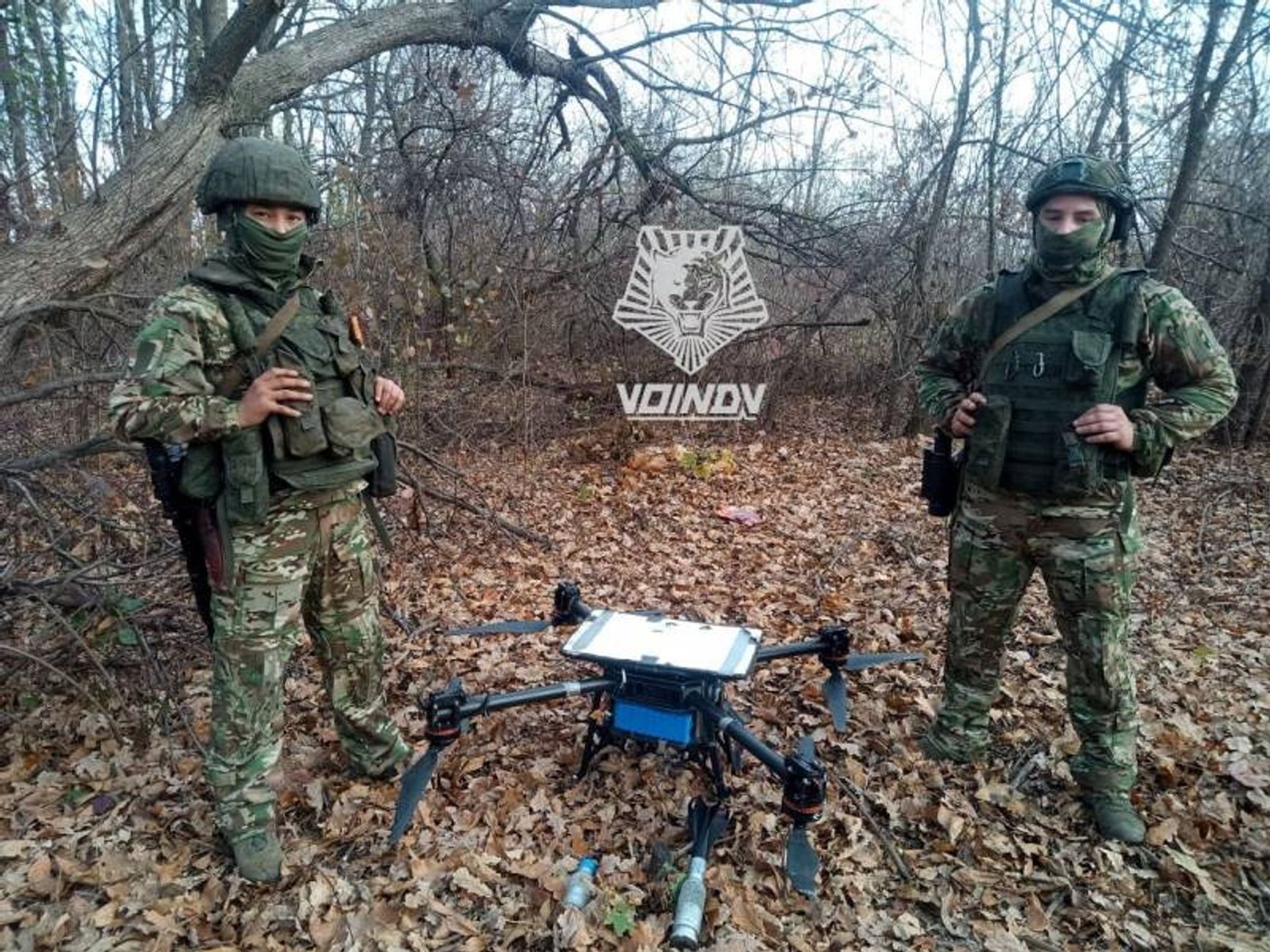
Moreover, both sides are adapting fixed-wing-type drones for air drops or creating new models specifically for this purpose. Initially, the Russians repurposed the Orlan-10 for this task, but due to the imprecision of bombing (as seen in videos from the Russian side where apparently none of the bombs hit the target) and the then-prevalent shortage of Orlans needed for reconnaissance missions, the endeavor, seemingly, did not gain widespread adoption. At least, the specialized munitions recently showcased during the formation of two new Ahmat spetsnaz regiments appear to be used with quadcopters rather than Orlans. The Ukrainian-developed Punisher drone seems to have been more successful.
FPV Revolution
Despite the effectiveness of air drops, perhaps the most significant contribution to the frontline situation in the past year has come from FPV drones. This abbreviation stands for First Person View—a perspective provided by a forward facing camera mounted on the drone; the operator pilots the drone by using special goggles. A typical FPV drone is a quadcopter equipped with a payload (such as a PG-7 anti-tank grenade) that detonates upon impact with the target. The key advantage of such drones lies in their high precision and the ability to infiltrate even the smallest openings, diminishing the effectiveness of cover.
MT-LB — a Soviet-designed multi-purpose lightly-armored tracked personnel carrier/transporter/tractor. Due to its excellent cross-country capacity, it is widely used by both sides for transporting personnel and cargo, towing artillery, as well as as the base for DIY and semi-DIY installation of various weapon systems from naval anti-aircraft guns to 100mm cannons
BTR — a family of Soviet, Russian and Ukrainian lightly armored wheeled personnel carriers
MLRS — multiple launch rocket system
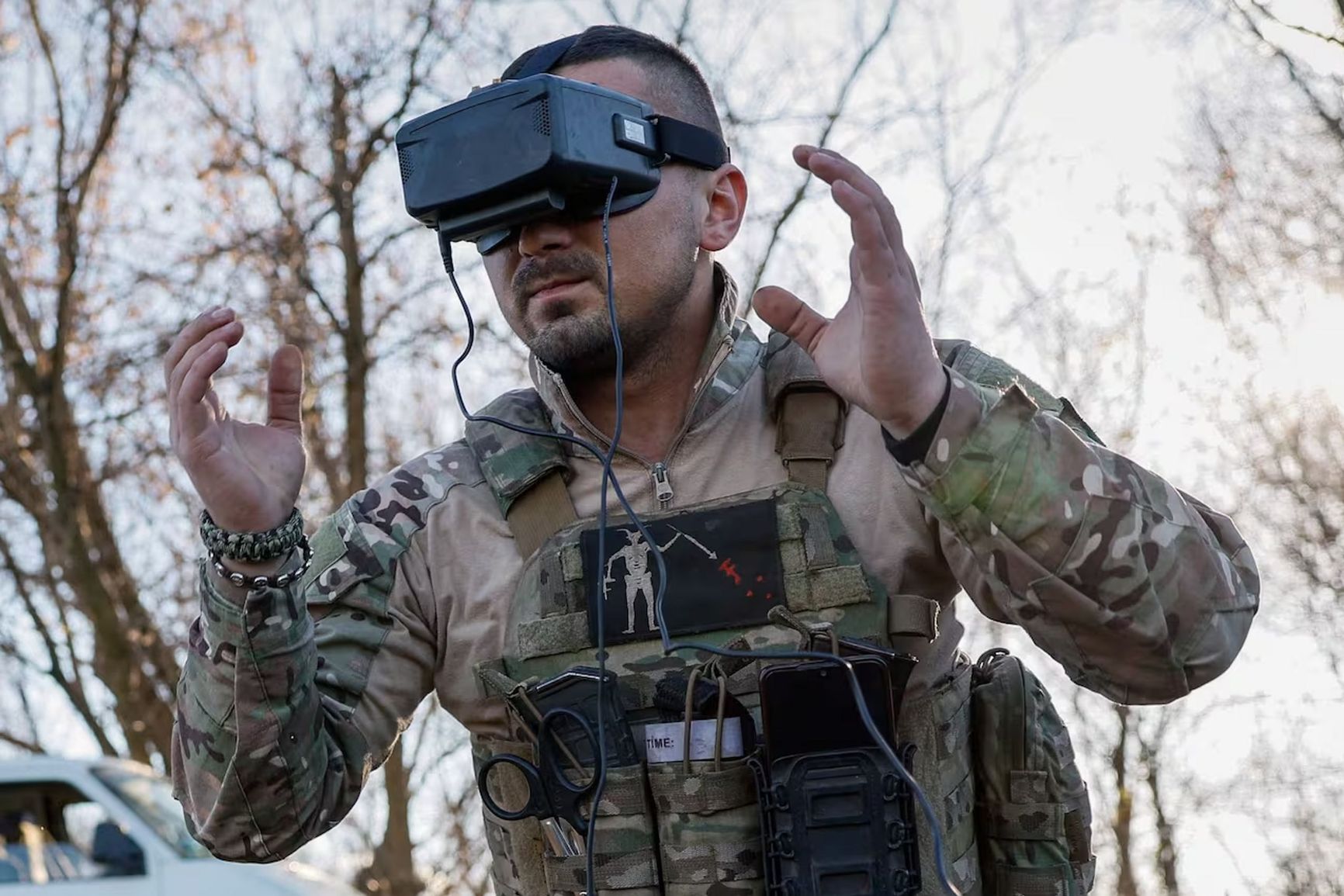
The operator of an FPV drone in action Alina Smutko / Reuters
In contrast to reconnaissance quadcopters (such as the Chinese Mavic and the American Autel, which are often purchased off the shelf), FPV drones are assembled in workshops using Chinese components, reducing their production costs. According to one Ukrainian manufacturer, the cost ranges from 11,500 to 27,000 hryvnias (from $300 to $700). For comparison, the cost of a conventional, non-high-precision artillery shell in Europe at the beginning of the year was €1,285 ($1,400), but now it reaches up to €8,600 ($9,300).
The use of FPV drones on the front lines began in 2022 and was initially quite limited, with the practical range of stable communication with the operator not exceeding 2 km. However, the use of such drones quickly expanded, surpassing air drops (at least, judging by the number of geolocated videos). Subsequently, thanks to special relay drones, the flight range was increased, allowing for attacks on air defense systems and MLRS, which can be located many kilometers away from the front.
Moreover, perhaps the greatest impact of kamikaze drones is on logistics: Ukrainian FPV drone operators have engaged in a real “bukhankacide,” hunting Russian UAZ minibuses (dubbed “bukhankas”, or «loafs», for their distinct shape) used for transporting various goods and personnel in the frontline areas. At the same time, tanks, including Western ones, also suffer from FPV drones, although penetrating the armor is not always successful.
MT-LB — a Soviet-designed multi-purpose lightly-armored tracked personnel carrier/transporter/tractor. Due to its excellent cross-country capacity, it is widely used by both sides for transporting personnel and cargo, towing artillery, as well as as the base for DIY and semi-DIY installation of various weapon systems from naval anti-aircraft guns to 100mm cannons
BTR — a family of Soviet, Russian and Ukrainian lightly armored wheeled personnel carriers
MLRS — multiple launch rocket system
Kamikaze drones allow for both fending off enemy attacks and providing precise fire support during assaults on enemy trenches. Among the drawbacks of FPV drones is their insufficient protection against electronic warfare: they can be deprived of control or have their video channel intercepted, exposing the operators' positions.
Nevertheless, the overall effectiveness of FPV drones is so significant that Western analysts (1, 2) see the expansion of their production as an opportunity for Ukraine to weather the impending ammunition shortage. However, even they acknowledge the challenges in scaling up production: Ukraine faces a shortage of engineers, and according to industry representatives, FPV drone production in Russia exceeds Ukrainian figures by a factor of six.
Ukrainian Serhiy Sternenko, who fundraises to equipe Ukrainian soldiers with drones and other assets, believes that the problem lies in the lack of a systematic approach to new drones from the Ukrainian military-political leadership, whereas production in Russia is organized under the auspices of the Ministry of Defense. He also mentions that the Russians, entering the FPV drone race later than Ukraine, have now found themselves somewhat ahead—in particular, in the use of drones with thermal imagers during nighttime, further complicating the already challenging logistics situation.
A crucial factor in the application of FPV drones is their psychological impact, explained by a Ukrainian entrepreneur who has established mass production of such drones in Ukraine to The Insider: “Imagine the scene: two Russian soldiers in the field see a drone approaching and choosing which one of them it will target, and they look at it utterly helpless. Such videos are published literally every day in Telegram channels. The realization that soldiers and equipment are completely defenseless against such a threat demoralizes those in combat.” The entrepreneur agrees that if at the beginning of the war, Ukraine was a step ahead in the production and application of FPV drones, Russia is now addressing this on a government level, while in Ukraine, it largely remains the work of volunteers with modest resources.
Fixed-wing drones: the downfall of the Bayraktar, the rise of the Orlan and Lancet
It's hard to believe that just two years ago discussions of military UAVs mostly referred to relatively large fixed-wing drones, not commercial or homemade quadcopters. American reconnaissance and strike drones like the MQ-1 Predator and MQ-9 Reaper, patrolling the skies of the Middle East and striking targets with precision Hellfire missiles, became symbols of the War on terror. Other regional players, including Iran, Turkey, and Russia, also sought to catch up with the United States.
Meanwhile, as military expert Pavel Luzin notes, although the offensive capabilities of Russian UAVs left much to be desired, the reconnaissance UAV program had been many years in the development. Drones such as the Orlan and Forpost (licensed copy of the Israeli IAI Searcher) were actively used in Ukraine and Syria since the mid-2010s. Nevertheless, by the time of the full-scale invasion of Ukraine, the provision of Russian troops with reconnaissance UAVs was clearly insufficient, and the process from target detection to engagement (referred to as the “kill chain“ in the U.S.) was unreasonably long.
In contrast, Ukraine, having surged ahead in the use of commercial UAVs, found itself in the position of having to catch up with Russia in the field of military-grade reconnaissance and strike UAVs. Certain steps were taken even before the major war: the Bayraktar TB2 drones purchased from Turkey were first showcased in a parade in August 2021, and by October, one of these drones was employed for the first time in the Donbas, striking a “DNR” artillery battery. Ukrainian analogs of the Orlan, such as Leleka, Furiya, and PD-1, were also in development. However, large-scale production of such UAVs only began after the start of the full-scale war, often based on private initiatives.
MT-LB — a Soviet-designed multi-purpose lightly-armored tracked personnel carrier/transporter/tractor. Due to its excellent cross-country capacity, it is widely used by both sides for transporting personnel and cargo, towing artillery, as well as as the base for DIY and semi-DIY installation of various weapon systems from naval anti-aircraft guns to 100mm cannons
BTR — a family of Soviet, Russian and Ukrainian lightly armored wheeled personnel carriers
MLRS — multiple launch rocket system
Ukraine found itself in the position of having to catch up with Russia in the field of military-grade reconnaissance and strike UAVs
It was the lack of reconnaissance UAVs that led to the boom in quadcopters on both sides of the frontline. However, despite their usefulness at the lowest level, commercial drones are unable to fully replace a full-fledged reconnaissance UAV, which can stay in the air for many hours and fly dozens of kilometers behind enemy lines. Such UAVs are indispensable for both sides in adjusting the fire of precision long-range weapons, such as HIMARS rocket systems or the Iskander ballistic missile system.
MT-LB — a Soviet-designed multi-purpose lightly-armored tracked personnel carrier/transporter/tractor. Due to its excellent cross-country capacity, it is widely used by both sides for transporting personnel and cargo, towing artillery, as well as as the base for DIY and semi-DIY installation of various weapon systems from naval anti-aircraft guns to 100mm cannons
BTR — a family of Soviet, Russian and Ukrainian lightly armored wheeled personnel carriers
MLRS — multiple launch rocket system
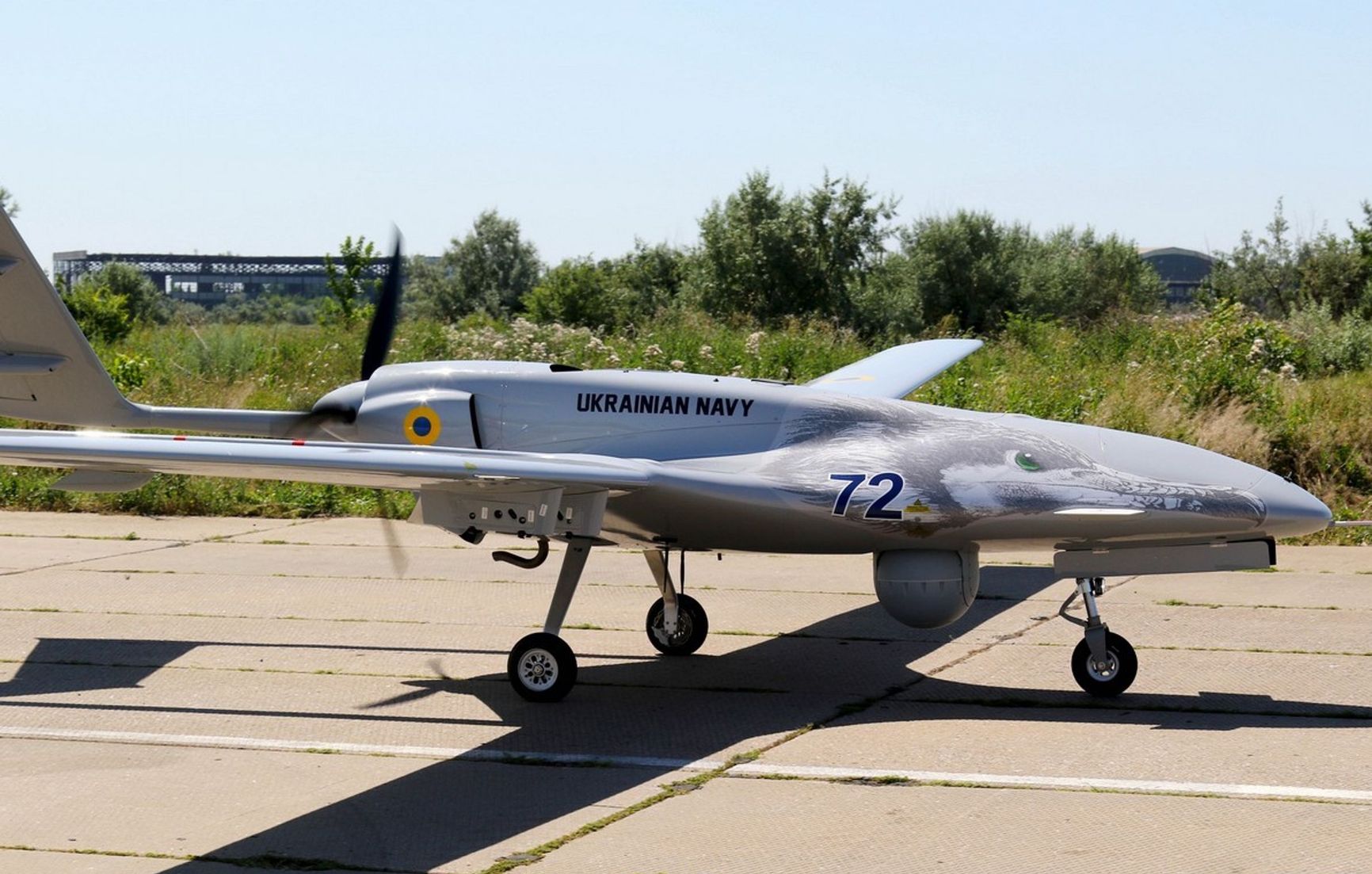
Bayraktar TB2 UAV, Ukrainian Naval Forces, July 15, 2021
Armiya Inform
Against this backdrop, the decline of heavy strike UAVs, such as the Bayraktar, went almost unnoticed—the same UAVs that frequently targeted columns of Russian vehicles in the chaos of the early war. Songs were composed, children and even a lemur at the Kyiv Zoo were named after these drones. However, after the front relatively stabilized, the Russians managed to deploy a multi-layered air defense system in the occupied territories. Subsequently, more and more footage (1, 2, 3, 4, 5) of downed Turkish drones began to appear online.
The slow-flying Bayraktars, which had success in conditions of weak or ineffective enemy air defense, proved to be relatively easy prey for Russian air defense systems. The last significant use of the Bayraktar TB2 occurred during the battle for Snake Island, where Russian air defense was relatively weak, but even there, the drones suffered losses. Samuel Bendett, an American military expert, explains that the remaining Bayraktars' role has shifted to reconnaissance: their advanced optics allow them to provide targeting information for other drones.
A similar inglorious fate awaited Russian Orion strike UAVs, intended to be the response to the Bayraktar, although their occasional use continues—in July, one of them crashed near Taganrog in the Rostov region of Russia. However, overall, Russia has maintained its leadership in the use of operational-tactical UAVs, as acknowledged by officers like Andriy Biletsky, the commander of the 3rd Separate Assault Brigade of the Armed Forces of Ukraine.
MT-LB — a Soviet-designed multi-purpose lightly-armored tracked personnel carrier/transporter/tractor. Due to its excellent cross-country capacity, it is widely used by both sides for transporting personnel and cargo, towing artillery, as well as as the base for DIY and semi-DIY installation of various weapon systems from naval anti-aircraft guns to 100mm cannons
BTR — a family of Soviet, Russian and Ukrainian lightly armored wheeled personnel carriers
MLRS — multiple launch rocket system
Russia has maintained its leadership in the use of operational-tactical UAVs
According to him, the Orlan surpasses Western and Ukrainian models, showing high resistance to Ukrainian electronic warfare (EW) assets. Its presence in the air, in the role of a scout and artillery spotter, paralyzes the operation of Ukrainian artillery systems and logistics. Meanwhile, the Ukrainian Armed Forces continue to use winged reconnaissance drones like the Furiya, including for artillery fire correction. The sky above the battlefield is filled with such a large variety of drones that Ukrainian Telegram channels have to share specific guidelines preventing Ukrainian anti-aircraft gunners from mistakenly shooting down their own drones while targeting Russian UAVs.
On the Russian side, the Supercam and Zala UAVs are widely employed alongside the Orlan. The Zala, in particular, is considered a significant threat, leading the Ukrainians to spare no HIMARS rockets to neutralize them. Zala's primary role involves target acquisition and guidance for the Lancet, another successful Russian “pre-war” kamikaze drone.
In a situation where Western artillery systems outperform Russian and Soviet counterparts in range and precision, the Lancet has become a crucial asset for counter-battery warfare (1, 2, 3). In November, according to released videos, these drones reportedly destroyed at least 27 Ukrainian military vehicles, including 12 artillery systems.
There are also known instances (1, 2) of Ukrainian aircraft being hit by Lancet drones at forward airfields dozens of kilometers from the front line. Judging by certain footage, Ukrainian engineers are working on their own version of the Lancet, but the initial prototypes (as well as the original) do not always hit the target.
Strategic UAVs: Shaheds, Beavers, and Ukroshaheds
The use of UAVs in the Russian-Ukrainian war extends beyond the battlefield and the immediate rear. Both sides employ drones that can be classified as strategic assets, as they are capable of striking targets across almost the entire territory of Ukraine and a significant part of western Russia.
Since last fall, Russia has been using Iranian kamikaze drones known as Shaheds over Ukrainian territory. Initially, these drones attempted to operate on the battlefield, but according to the US data, they did not meet expectations, shifting their targets to objects in the Ukrainian rear. This is unsurprising, as unlike the Lancet, Iranian drones do not maintain communication with the operator and follow a pre-programmed flight path to a designated point.
Despite this, at least initially, Shaheds managed to reach central Kyiv almost unhindered, where police fired at them with automatic weapons. Over time, anti-drone defenses improved, and a year later, the Ukrainian Air Force reported 74 out of 75 drones headed for Kyiv being successfully shot down. Nevertheless, Shaheds still manage to target both military and civilian objects, including ammunition depots, military airfields, and agricultural export infrastructure.
Apparently, the Russian command remains satisfied with the strategic use of Shaheds, not least due to their cost-effectiveness compared to cruise and ballistic missiles (as well as compared to the cost of the missiles used to shoot them down), as evidenced by the localization of the production of these drones in Russia under the name “Geran.”
The Russians didn't just copy the Iranian product but also made significant changes. For instance, they installed their Kometa-M antenna designed to counter electronic warfare, which surpasses its Iranian counterpart. In addition, the drones are equipped with a more powerful warhead and modems with SIM cards from the Ukrainian cell operator Kyivstar.
MT-LB — a Soviet-designed multi-purpose lightly-armored tracked personnel carrier/transporter/tractor. Due to its excellent cross-country capacity, it is widely used by both sides for transporting personnel and cargo, towing artillery, as well as as the base for DIY and semi-DIY installation of various weapon systems from naval anti-aircraft guns to 100mm cannons
BTR — a family of Soviet, Russian and Ukrainian lightly armored wheeled personnel carriers
MLRS — multiple launch rocket system
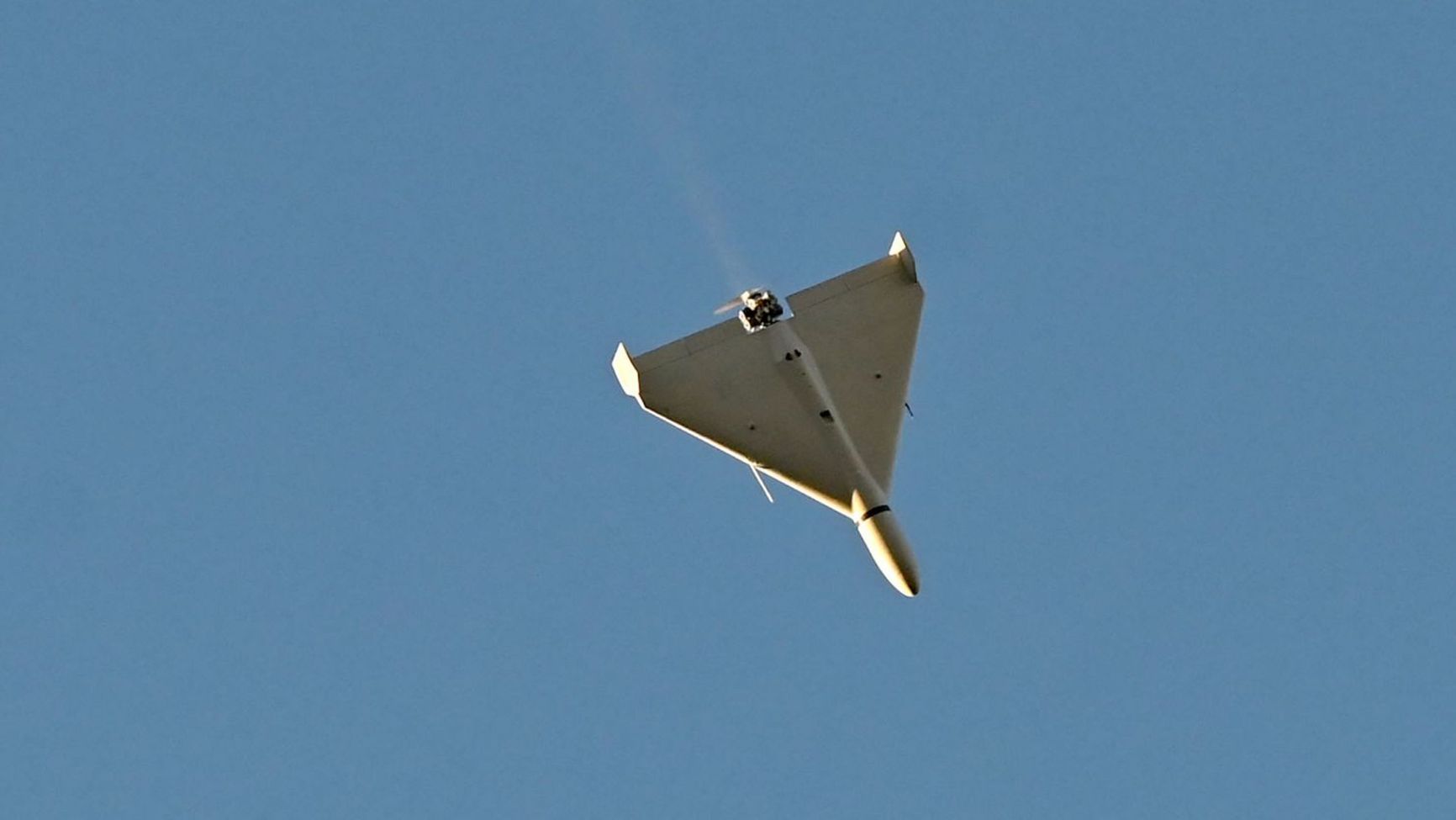
Shahed in the sky over Kyiv, October 17, 2022
Sergei Supinsky / AFP / Getty Images
Just like with Lancets, Ukrainian UAV developers strive to respond symmetrically to the Russians. The creation of long-range drones was reported by the state-owned Ukroboronprom back in October 2022—now, it is claimed that the project has already entered serial production. Simultaneously, volunteer projects were being developed, with the most well-known being the Bober («Beaver»), created with funds raised by volunteer Ihor Lachenkov. Most likely, drones like these have appeared multiple times (1, 2) in the sky over Moscow.
In addition to strikes on the Russian capital, which have more of a psychological impact, Ukrainian drones have targeted significant Russian military facilities. The most impressive were the strikes on airfields in the Pskov and Ryazan regions, where Russian Tu-22M3 strategic bombers were hit.
At the same time, the Ukrainian military intelligence (GUR) and Security Service of Ukraine (SBU) promise a symmetrical response to the possible resumption of attacks on Ukraine's energy infrastructure. Apparently, this response may be symmetrical even down to the drone design—on the day immediately following the massive air raid on Kyiv, drones resembling Shaheds were noticed over Russia.
Countering drones
Historically, the emergence of any new weapon on the battlefield stimulates the development of countermeasures. Tanks prompted the creation of anti-tank guns and grenades, aircraft led to anti-aircraft guns and radars, and submarines inspired sonars and depth charges. Various UAVs in the Russo-Ukrainian War are no exception, as developers of drones have, in turn, improved them to defend against new threats. This “sword and shield duel” is still ongoing.
Countermeasures against drones can be categorized as passive and active. Passive measures include various defensive systems that prevent the unmanned aerial vehicle from destroying its target. Active measures involve air defense systems and electronic warfare, aimed at shooting down or disrupting enemy UAVs. These measures are often used in conjunction to enhance overall effectiveness.
“Mangals”
The most well-known passive defense measure is the so-called “mangal“ (“barbecue grill” in English, also dubbed «cope cage» on Western social media). These structures first appeared on Russian tanks even before the full-scale invasion of Ukraine. It seems that, at that time, they were designed to protect against anti-tank guided missiles (ATGMs) like the Javelin, widely used by the Ukrainian Armed Forces. The missiles launched from these ATGMs approach the target from above. Their effectiveness at that time probably left much to be desired. However, they later proved useful against “drops” from Ukrainian drones. With the proliferation of those drones, “mangals” started appearing not only on tanks but also on other military vehicles.
MT-LB — a Soviet-designed multi-purpose lightly-armored tracked personnel carrier/transporter/tractor. Due to its excellent cross-country capacity, it is widely used by both sides for transporting personnel and cargo, towing artillery, as well as as the base for DIY and semi-DIY installation of various weapon systems from naval anti-aircraft guns to 100mm cannons
BTR — a family of Soviet, Russian and Ukrainian lightly armored wheeled personnel carriers
MLRS — multiple launch rocket system
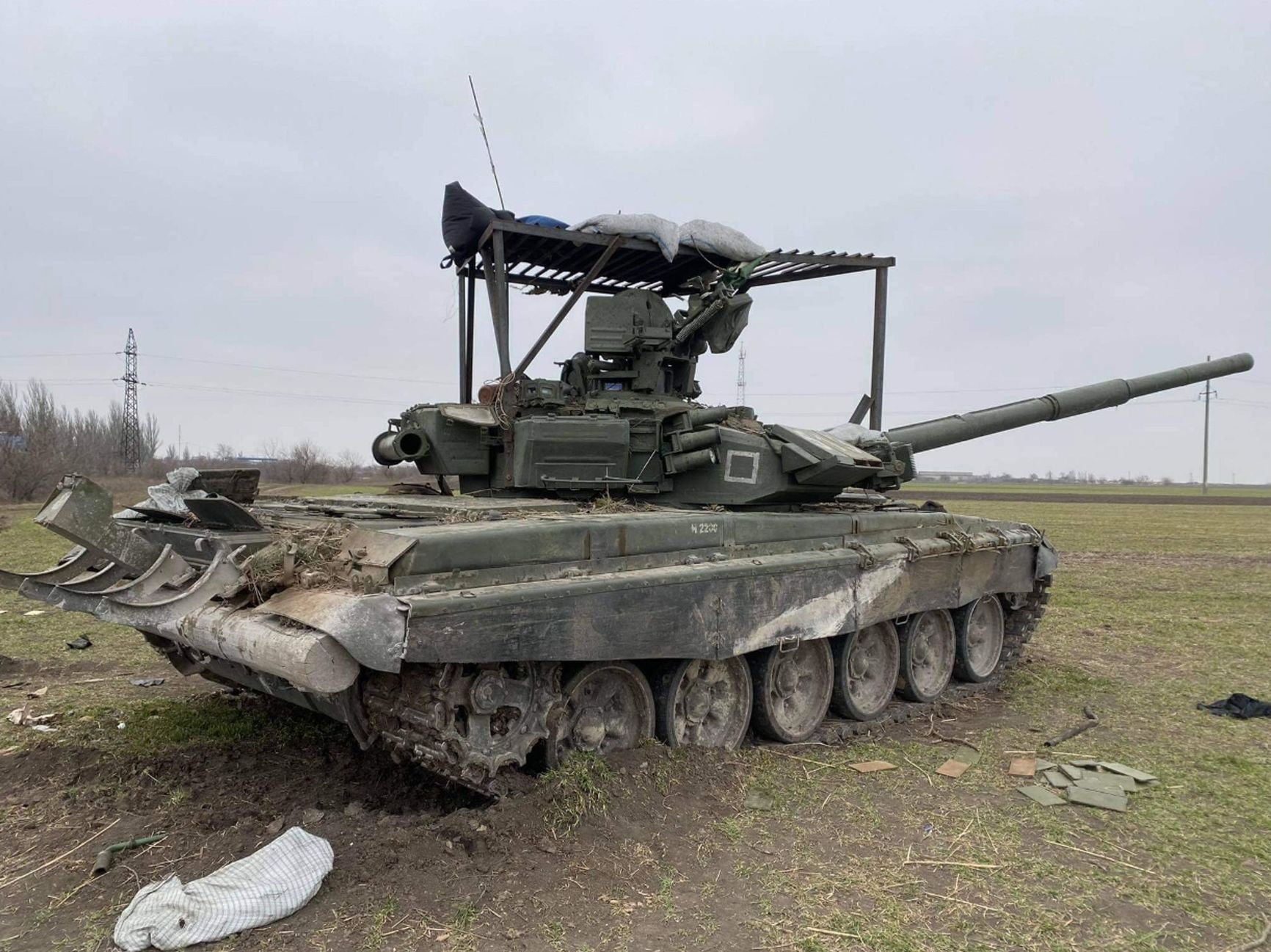
Damaged and abandoned Russian T-90A tank with a “mangal,” March 2022
MilitaryLand.net
Later, Russians began installing roof screens on new and upgraded tanks directly at the factory, where they were named “Explosive Reactive Armor Module 'Roof.'“ Additionally, the Main Armored Vehicles Directorate of the Ministry of Defense started issuing recommendations (1, 2) for installing protective screens in field conditions. It can be noted that the schematics suggest installing protection not only from above but also from the sides, which is related to the proliferation of FPV drones. On the other hand, it's interesting to note that the manual includes a recommended schematic for drone-proofing the relatively rare Shkval armored vehicle, but there is none, for example, for the more common bukhanka mini-buses, which, despite their prevalence on the front line, are largely crowdfunded and officially are not part of the inventory of the Russian Armed Forces.
It is also worth noting that the shielding interferes with evacuating from a disabled vehicle through the hatch in the turret, which is why such contraptions are also called (1, 2) “anti-get-the-f**k-out devices”. Some implementations (1, 2) even reduce the combat capabilities of the vehicle, depriving it of the ability to rotate the turret (however, in the case of the T-62, this is not as critical, as these outdated tanks are often not involved in frontline combat but are used as improvised self-propelled artillery). At the same time, it is still unclear how well such screens protect against drones, although there is some evidence (1, 2) in favor of their effectiveness.
MT-LB — a Soviet-designed multi-purpose lightly-armored tracked personnel carrier/transporter/tractor. Due to its excellent cross-country capacity, it is widely used by both sides for transporting personnel and cargo, towing artillery, as well as as the base for DIY and semi-DIY installation of various weapon systems from naval anti-aircraft guns to 100mm cannons
BTR — a family of Soviet, Russian and Ukrainian lightly armored wheeled personnel carriers
MLRS — multiple launch rocket system
The mangal interferes with evacuating from a disabled vehicle through the hatch in the turret
Ukrainian tanks with “mangals” are rarely encountered (although this may change with the proliferation of “air drops” and FPV drones in the Russian Armed Forces). In the Ukrainian Armed Forces, the construction of protective structures is often carried out by artillery units, which erect entire anti-Lancet “shacks” around artillery pieces. At least in this case, it is well-established that the mesh is indeed capable of stopping the flight of a drone.
Additionally, the structure can be covered with a camouflage net to conceal a position from the air. However, there have been recent discussions about the emergence of the Lancet with a warhead generating an “explosively formed penetrator,” which, unlike the jet from a conventional shaped charge, cannot be stopped by a mesh. A similar modification of the warhead of a US drone (presumably referring to the Switchblade 300) has also been developed in Ukraine.
Fake tanks
Decoy versions of various military equipment used by both sides should also be classified as “passive” means of defense. Such measures have been taken as long as military aviation has existed, but nowadays, the task is complicated by the fact that the camera of a reconnaissance drone clearly captures all the details. Therefore, the decoys must closely resemble the original, and the position itself must be arranged to look inhabited (for example, by scattering around shell boxes and casings).
For the Ukrainian Armed Forces, these decoys are produced both abroad and domestically. They look quite realistic, with some exceptions, so Lancet operators have not only fallen for the bait but also shared videos of destroying false targets online (1, 2, 3, 4). The quality of Russian decoys generally leaves much to be desired (1, 2), but even such structures can mislead (1, 2) enemy aerial reconnaissance.
“Old-school” anti-aircraft guns, Maxim machine guns, and conventional small arms
Active anti-drone defense includes air defense systems (ADS) and electronic warfare systems (EWS). The variety of ADS used to neutralize drones is impressive. Modern anti-aircraft missile systems (AAMS) designed to counter enemy aircraft and cruise missiles have proven less effective against small and hard-to-detect drones. However, due to the low speed and vulnerability of drones, it has been discovered that “old-school” methods are suitable for countering them.
Surprisingly, German Gepard self-propelled anti-aircraft guns (SPAAG) from the 1960s have shown themselves to be effective, thanks to the presence of radar and a computerized fire control system. If a Gepard is not available, one can turn to the Soviet Shilka SPAAG (including its Polish modification Biala) or take an unconventional Russian approach, mounting naval anti-aircraft guns or tail machine guns for defense against FPV drones on MT-LBs. As more of a curiosity, “air rams“ can be highlighted, where a drone operator, encountering an enemy drone over the battlefield, tries to make physical contact and bring it down, risking the loss of their own (often quite expensive) device in the process.
MT-LB — a Soviet-designed multi-purpose lightly-armored tracked personnel carrier/transporter/tractor. Due to its excellent cross-country capacity, it is widely used by both sides for transporting personnel and cargo, towing artillery, as well as as the base for DIY and semi-DIY installation of various weapon systems from naval anti-aircraft guns to 100mm cannons
BTR — a family of Soviet, Russian and Ukrainian lightly armored wheeled personnel carriers
MLRS — multiple launch rocket system
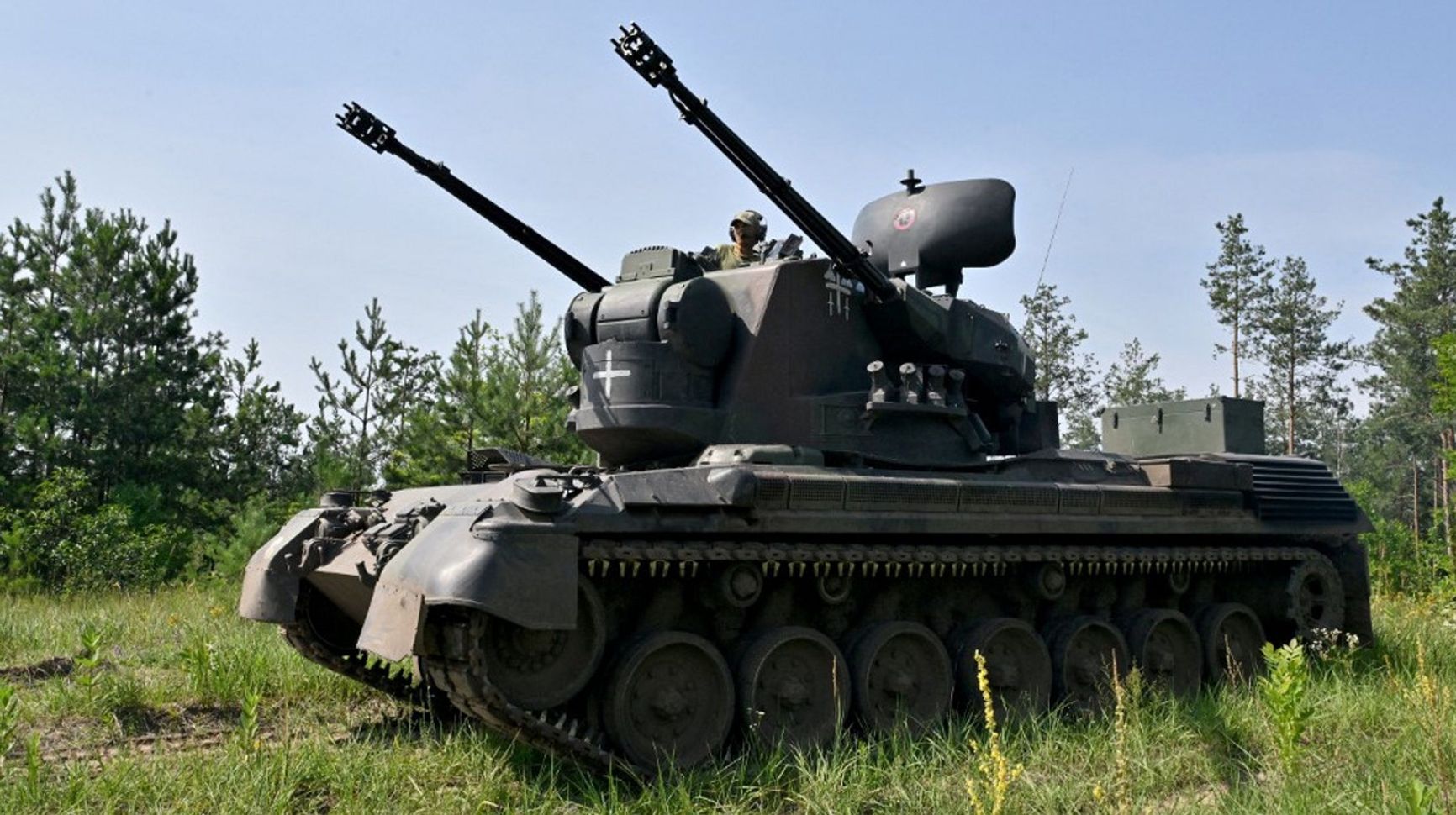
Gepard SPAAG near Kyiv, July 26, 2023
Sergei Supinsky / AFP
Often, very old tactics come to the rescue, such as suppressive fire from small arms. After the onset of Shahed attacks, a guide on choosing the aiming point to hit a kamikaze drone began circulating on Ukrainian social media. Similar (though much less detailed) guides were distributed to Soviet soldiers during World War II.
It is challenging for a lone shooter to hit a flying drone, especially at night (although it is possible with the help of a thermal imager, as the Russians found out in the fight against the Baba-Yaga). However, creating a hail of bullets in the drone's path allows it to be shot down. Another revived ADS from archival reels is multi-barreled installations assembled from Maxim machine guns (once used by the Soviet and Finnish armies).
These and other Ukrainian ADS are organized into mobile groups that promptly move into the flight paths of Shaheds. For ease of shooting, these groups use spotlights, reminiscent of the 1940s London Blitz. In turn, the Russians are reviving “anti-aircraft towers“ used to defend German cities from Allied air raids—only now, instead of anti-aircraft guns, they mount Pantsir-S SAM system on towers around Moscow.
Electronic Warfare
However, alongside the “old-school” methods of countering drones, modern ones are also being widely used, primarily those relating to electronic warfare systems (EWS). In this regard, the Russians also had a significant edge, as “large” EWSs had been continuously developed in Russia over the past decades. However, powerful systems proved insufficient across thousands of kilometers of the front: even from such critical directions as the left bank of the Dnieper, Russian soldiers report that “we either have no EWS, or [the Ukrainian drones] just ignore it.”
Moreover, EWSs do not always fulfill their direct function (a good example is the destruction of a Strizh EWS installation, designed to counter drones, by an FPV drone). When a Russian EWS does work, its victims often include “our own planes and copters.” However, despite the shortcomings, British experts estimated this spring that a significant portion of Ukrainian drone losses, numbering up to 10,000 drones per month, can be attributed to Russian EWS.
Nevertheless, the shortage of “large” EW systems forces Russian and Ukrainian soldiers to acquire small, or “trench,” EWSs, either buying them at their own expense or receiving them from volunteers. Electromagnetic anti-drone guns, which can disrupt the connection between the drone and the operator, have become prevalent in this category. A drone that has lost control often hovers in one place, making it relatively easy to bring down with small arms or even a stick.
However, anti-drone guns do not provide a 100% guarantee of neutralizing enemy copters and are also ineffective against FPV drones that approach the target quickly and from unexpected angles. Therefore, the military seeks to acquire “dome” electronic warfare assets whose action extends in all directions. A widely known example is the Russian Volnorez and Triton systems, recommended for installation on armored vehicles alongside protective screens.
However, even armored vehicles with installed electronic warfare systems will not be completely protected from drone attacks. According to the assessment of Ukrainian military specialist Sergey “Flash” Beskrestnov, the average effectiveness of such solutions is 30–35%. The task is complicated by the fact that the adversary can simply change the frequencies on which FPV drones operate, rendering most electronic warfare devices useless.
According to Beskrestnov, the AFU are equipped with less than 20% of the required systems, both large and small. As one way to address this issue, Beskrestnov suggests employing frequency analyzers. While these analyzers don't provide protection against drones, they play a crucial role in detecting drone presence by analyzing the frequency each drone operates on. Comparable systems are also being distributed by Russian pro-military volunteers.
The shortage of electronic warfare assets on the front line may be explained in part by their active use for protecting facilities located in the rear against strategic drones. The Russian Ministry of Defense regularly reports on suppressing AFU drones over the territory of Russia and Crimea using electronic warfare systems. The consequences of such suppresion became evident in a particular case when a kamikaze drone, presumably losing control due to the influence of an electronic warfare system, crashed into a residential building in Tula. In Ukraine, a system called Pokrova is being developed, which is intended to protect Ukrainian cities from drones and cruise missiles by suppressing or spoofing GPS navigation systems.
In conclusion, it can be said that both drones and anti-drone equipment are constantly evolving, transforming certain aspects of warfare beyond recognition. This process may be discussed endlessly—this article, for instance, does not touch upon the vast topics of maritime and ground drones. Although the notion of absolute drone dominance on the battlefield may be somewhat overestimated, one cannot deny their significant impact on military operations—as well as the fact that superiority in UAVs for one side will increase its chances of victory. This applies not only to the Russo-Ukrainian war but also to any other potential conflicts.
MT-LB — a Soviet-designed multi-purpose lightly-armored tracked personnel carrier/transporter/tractor. Due to its excellent cross-country capacity, it is widely used by both sides for transporting personnel and cargo, towing artillery, as well as as the base for DIY and semi-DIY installation of various weapon systems from naval anti-aircraft guns to 100mm cannons
BTR — a family of Soviet, Russian and Ukrainian lightly armored wheeled personnel carriers
MLRS — multiple launch rocket system